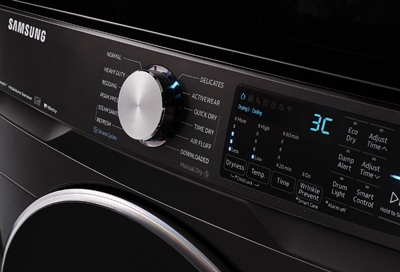Samsung dryer not heating? Check the heating element and thermal fuse for potential issues.
Lack of heat may indicate a defective part. Troubleshooting these components can help resolve the problem efficiently. A malfunctioning dryer can disrupt your daily routine, causing inconvenience and frustration. Understanding common reasons for heating issues can save time and money on repairs.
By addressing the problem promptly, you can ensure your Samsung dryer functions effectively and prolong its lifespan. With proper maintenance and timely repairs, you can prevent future heating problems and maintain the efficiency of your appliance. Trusting professionals for complex repairs is advisable to avoid further damage and ensure safe operation of your Samsung dryer.
Common Causes
A malfunctioning Samsung dryer not heating properly can be frustrating and inconvenient. Understanding the common causes of this issue is crucial to troubleshooting and resolving the problem. Below, we outline the typical culprits behind a Samsung dryer that fails to produce adequate heat.
Faulty Heating Element
The heating element in a Samsung dryer is responsible for generating heat to dry the clothes. If the element is defective or damaged, the dryer may not produce enough heat or may fail to heat at all. Check the heating element for any visible signs of damage or wear, such as breaks or hot spots, and consider replacing it if necessary.
Thermostat Issues
The thermostat in the Samsung dryer controls the temperature inside the drum. If the thermostat malfunctions, it can result in inadequate heat production or complete failure to heat. Verify the condition of the thermostat and its connections, and replace it if it appears to be the source of the problem.
Clogged Vents
Clogged vents can obstruct the airflow in the dryer, leading to insufficient heat distribution. Regularly check and clean the dryer vents to prevent blockages caused by lint, debris, or other obstructions. Ensuring that the vents are clear and free from any impediments is essential for the proper functioning of the dryer.
Troubleshooting Steps
When your Samsung dryer is not heating up, it can be frustrating. However, there are some simple troubleshooting steps you can follow to identify and potentially resolve the issue. By checking the power supply, inspecting the heating element, and testing the thermostat, you can diagnose and fix the problem efficiently.
Check Power Supply
1. Ensure the dryer is plugged in securely.
2. Inspect the circuit breaker to make sure it hasn’t tripped.
Inspect Heating Element
1. Unplug the dryer before proceeding.
2. Locate the heating element at the back of the dryer.
Test Thermostat
1. Access the thermostat inside the dryer cabinet.
2. Use a multimeter to test the thermostat for continuity.
Preventive Maintenance
When it comes to your Samsung dryer, preventive maintenance is key in ensuring it functions optimally. Let’s delve into some essential maintenance tips to keep your dryer running smoothly.
Clean The Lint Filter
- Regularly clean the lint filter after every use to prevent blockages.
- Remove lint by hand or use a brush to keep the filter unclogged.
Regularly Clean The Vents
- Clean the dryer vents to prevent lint buildup and ensure proper airflow.
- Use a vacuum or dryer vent brush to clear any debris obstructing the vents.
Avoid Overloading The Dryer
- Prevent overloading to allow proper circulation for effective drying.
- Follow manufacturer guidelines for load capacity to avoid strain on the dryer.

Credit: www.wikihow.com
Calling A Professional
If your Samsung dryer is still not heating after troubleshooting the common issues, it might be time to call in a professional technician. Identifying the right time to seek professional help is crucial for avoiding further damage to your appliance and ensuring its efficient repair.
When To Call A Technician
- If your Samsung dryer consistently fails to produce heat, despite checking the power supply and venting system, it’s a clear sign to seek professional assistance.
- When internal components such as the heating element, thermostat, or thermal fuse need inspection or replacement, a skilled technician is necessary to handle these complex repairs.
- Any unusual noises, burning smells, or visible damage within the dryer should prompt a professional assessment to prevent safety hazards and ensure proper functioning.
How To Find A Reliable Repair Service
- Research local repair services with specialized experience in Samsung appliances to ensure they are well-versed in tackling the specific issues of your dryer.
- Seek recommendations from family, friends, or online reviews to find a reputable and reliable repair service that delivers quality craftsmanship and customer satisfaction.
- Verify the technician’s certifications and training to guarantee their expertise in handling Samsung dryer repairs, providing peace of mind and assurance of a job well done.
- Inquire about warranties and guarantees for the repair work to ensure protection against recurring issues and to secure your investment in the appliance’s longevity.
Tips For A More Efficient Dryer
If your Samsung dryer is not heating properly, it can be a frustrating experience. Not only does it prolong the time it takes to dry your clothes, but it can also be a sign of a bigger problem. However, there are several tips you can follow to make your dryer more efficient and ensure your clothes are dried thoroughly, quickly, and without any damage.
Use The Appropriate Drying Cycle
Using the appropriate drying cycle for the type of clothes you are drying is essential for a more efficient dryer. Different fabrics have different drying requirements, and selecting the right cycle can help optimize the drying process.
For delicate fabrics such as silk or lace, select the “Delicates” cycle, which uses low heat and gentle tumbling. On the other hand, for heavier items like towels or jeans, choose the “Heavy Duty” cycle, which uses higher heat and longer drying times to effectively dry these items.
Dry Similar Fabrics Together
Drying similar fabrics together can help improve dryer efficiency. Sorting your laundry by fabric type before loading the dryer can ensure that the items have similar drying needs. This way, you can avoid situations where some clothes are under-dried while others are over-dried.
Create separate piles for cotton, synthetics, and delicates to prevent them from getting mixed together. This simple step can significantly improve the quality of your drying and save you time in the process.
Avoid Overdrying
Overdrying your clothes not only wastes energy but can also cause unnecessary wear and tear on your fabrics. To avoid this, it’s important to ensure that you never leave your clothes in the dryer longer than necessary.
Start by setting the dryer to a specific cycle that matches the drying needs of your clothes. When the cycle completes, promptly take out your clothes and fold or hang them. Make sure to check the moisture levels of your clothes during the drying process to determine when they are adequately dried, preventing excessive drying time.
By following these tips, you can make your Samsung dryer more efficient and ensure that your clothes are dried in the most effective way possible. Taking care of your appliance and using it correctly will not only save you time and energy but also help extend the lifespan of both your dryer and clothes.

Credit: m.youtube.com

Credit: www.samsung.com
Frequently Asked Questions Of Samsung Dryer Not Heating
Why Is My Samsung Dryer Running But Not Heating?
If your Samsung dryer is running but not heating, it could be due to a faulty heating element or a broken thermostat. Other possible reasons include a tripped circuit breaker or a clogged vent. Check these components and address any issues to restore the heating function of your dryer.
How Do I Reset The Heater On My Samsung Dryer?
To reset the heater on your Samsung dryer, unplug the dryer for 5 minutes, then plug it back in. If the issue persists, check the power supply and circuit breaker. If needed, contact Samsung customer support for further assistance.
Why Is My Dryer Running But Not Heating?
A dryer running but not heating may have a faulty heating element or thermal fuse. Check these components for issues.
How Do I Know If My Heating Element Is Bad On My Samsung Dryer?
You can tell if the heating element in your Samsung dryer is bad if there is no heat produced during the drying cycle. Another sign is if your clothes are still damp after a full cycle. Check for continuity using a multimeter to confirm the issue.
Conclusion
In troubleshooting your Samsung dryer not heating, it’s important to explore various potential causes and solutions. By understanding the common issues and following the recommended steps, you can effectively address the problem and restore your dryer’s functionality. Don’t hesitate to seek professional assistance if needed to ensure your dryer operates at its best.


